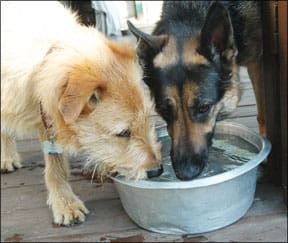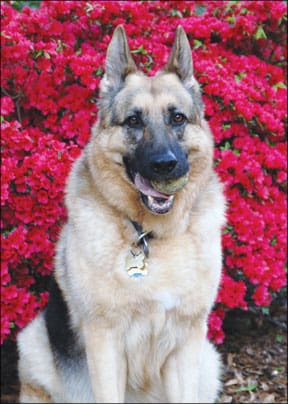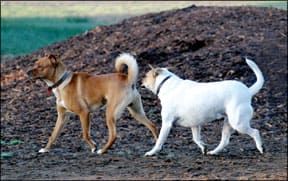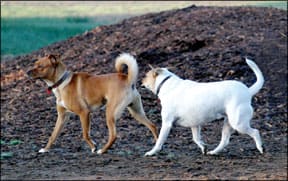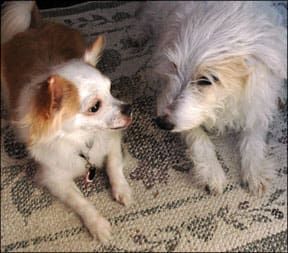Bladder and kidney stones are serious problems in dogs as well as people. These conditions – which are also known as uroliths or urinary calculi – can be excruciatingly painful as well as potentially fatal. Fortunately, informed caregivers can do much to prevent the formation of stones and in some cases actually help treat stones that develop.
Last month, we described struvite stones. Struvites contain magnesium, ammonium, and phosphate. They almost always occur in the bladder in combination with a bacterial infection and are most frequently found in small-breed females.
This month, we examine calcium oxalate or “CaOx” stones.
Calcium oxalate stones
CaOx stones occur in both the bladder (lower urinary tract) and kidneys (upper urinary tract) of male and female dogs. Most calcium oxalate uroliths are nephroliths (found in the kidney), and most of the affected patients are small-breed males. CaOx uroliths are radiopaque and most are easily seen on radiographs (X-rays).
In addition to breed and sex, risk factors for CaOx stones include being overweight, under-exercised, neutered, and eating a dry food diet, which contributes to more concentrated urine. Small dogs are thought to be more susceptible because they drink less water relative to their size than large dogs do.
One risk factor is insufficient or abnormal nephrocalcin, a strongly acidic glycoprotein present in normal urine that inhibits calcium oxalate crystal growth. Dogs who produce normal and sufficient nephrocalcin have a reduced risk of developing calcium oxalate stones.
Certain prescription drugs contribute to the formation of CaOx uroliths. Prednisone and other cortisone-type medications prescribed for inflammatory illnesses such as arthritis, itchy skin, or inflammatory bowel disease, can contribute to the formation of CaOx stones. So can the diuretic drug furosemide (brand names Lasix or Salix), which is given to dogs with congestive heart failure. Thiazide-class diuretics are recommended in place of furosemide for dogs who are prone to forming CaOx stones. Some nutritional supplements, such as vitamins C and D, are believed to contribute to oxalate stone formation.
Uroliths can develop in any breed, but the greatest number of calcium oxalate stones presented for analysis have come from Miniature Schnauzers, Bichon Frises, Standard Schnauzers, Lhasa Apsos, Shih Tzus, Yorkshire Terriers, Miniature Poodles, Pomeranians, Parson Russell Terriers, Papillons, Keeshonds, Samoyeds, Chihuahuas, Cairn Terriers, Maltese, Toy Poodles, West Highland White Terriers, Dachshunds, and mixed breeds.
Cocker Spaniels, German Shepherds, Golden Retrievers, and Labrador Retrievers are believed to be at decreased risk of CaOx stones.
Conventional veterinary practitioners tend to consider calcium oxalate stones irreversible, unaffected by diet or medical therapy, and untreatable except by surgery. They may attempt to remove small bladder stones by flushing the bladder with sterile saline, or perform shock wave or laser lithotripsy (processes that break stones into small pieces that can be flushed out or excreted in the dog’s urine).
Uroliths pose a more serious problem for male dogs than females, because their urine travels through a hollow bone (os penis) that surrounds the urethra within the penis. The bone cannot stretch or expand to accommodate a stone traveling through it, and obstructions readily result.
For males with recurring stones, a surgical procedure called urethrostomy sends urine on a new path, avoiding the os penis. The urethrostomy creates a new urinary opening in the scrotum area. This type of surgery cannot be performed unless the dog is neutered; if he is intact, he can be neutered at the time of the urethrostomy.
In up to 60 percent of conventionally treated patients, calcium oxalate stones recur within three years. In dogs with Cushing’s Disease (hyperadrenocorticism) or excessive calcium in the blood (hypercalcemia), both of which predispose dogs to CaOx stones, the recurrence rate is faster. It’s important to treat these underlying causes, if found, to help prevent recurrence. The recurrence rate among Bichons is higher than for any other breed.
Calcium oxalate crystals are of concern, but their presence doesn’t necessarily mean your dog is at risk of forming stones. Crystals are significant only if found in fresh urine. Crystals that form when urine is refrigerated or analyzed more than 30 minutes after collection may be incidental and not indicative of a problem. Dogs with calcium oxalate crystals in fresh urine should be monitored, and if the finding continues, steps should be taken to reduce the risk of stone formation, particularly in breeds most commonly affected.
Death sentence to discovery
In 1997, Molly McMouse, a 14-year-old Lhasa Apso belonging to Leslie Bean of Houston, Texas, was diagnosed with very dense, inoperable calcium oxalate stones affecting both kidneys. Bean owned three more Lhasas – 15-year-old FuzzerBear, 13-year-old Peepers, and 11-year-old CB Wigglesworth – who were closely related to Molly. Fearful that her other dogs could be afflicted by the same condition, Bean had them tested, and was shattered when each received the same diagnosis.

“My husband and I were told that oxalates only proliferate in size and number,” she recalls, “and that as the calcification of their kidneys increased, all four of our dogs would die, probably within six to nine months.”
At the time, Bean was founding director of patient advocacy at the University of Texas MD Anderson Cancer Center, a position that helped her contact medical experts of every description. She checked with veterinarians, veterinary researchers, and directors of veterinary schools and laboratories around the country, only to receive the same sad news from all.
“Every one of them said these stones cannot be dissolved,” she says. “They all felt bad about it, but they agreed that the prognosis for my dogs was hopeless.”
Bean’s Lhasas had been on a premium, holistic food, but after their diagnoses, at the recommendation of their veterinarians, Bean put them on a low-protein, low-phosphorus, low-sodium prescription diet. The dogs disliked the new food and their to-the-floor show coats rapidly dulled.
At that point, Bean says, “I accepted the fact that my dogs were going to die but I wanted to make their final months as terrific as possible.” Tossing the prescription food, she began feeding fresh foods such as lamb and peas, chicken and rice, and beef and broccoli. “I figured if they had so little time, they were damned well going to enjoy what they ate,” she says, “and they loved it. I can still see them dancing with joy when I carried their bowls to their places. Literally within two weeks they began acting more energetic, looked younger, had a spring in their step, and their eyes were clearer. Their coats looked better, too, and we soon had to cut almost an inch in length from each dog every month. Although that is common in young Lhasas in show coat, the rate of growth slows with age, so this was a really noticeable difference.” Because oxalic acid forms strong mineral bonds that can become calcium oxalate crystals and eventually CaOx stones, Bean speculated that low-oxalate foods might help prevent the stones’ formation (see “Oxalates in food,” page 9), and she made those ingredients the foundation of her dogs’ menus.
Protein
In the past, diets restricted in both protein and phosphorus were thought to reduce the risk of calcium oxalate formation. Studies found, however, that dietary phosphorus restriction increased calcium absorption and the risk of calcium oxalate formation, while higher levels of dietary protein reduced the risk of uroliths. Current recommendations for dogs prone to forming CaOx stones say that diets should not be restricted in protein, calcium, or phosphorus.
In February 2002, The American Journal of Veterinary Research published a study conducted at the University of Minnesota College of Veterinary Medicine’s Minnesota Urolith Center that compared dietary factors in canned food with the formation of calcium oxalate uroliths in dogs, with surprising results. Canned diets with the highest amount of carbohydrate were associated with an increased risk of CaOx urolith formation. Contrary to commonly accepted beliefs, the study concluded that “canned diets formulated to contain high amounts of protein, fat, calcium, phosphorus, magnesium, sodium, potassium, chloride, and moisture and a low amount of carbohydrate may minimize the risk of CaOx urolith formation in dogs.”
In contrast, Hill’s Canine u/d, often prescribed for dogs prone to forming CaOx stones, is low in protein, calcium, phosphorus, magnesium, and potassium.
At the beginning of her nutritional experiment, Bean reduced her dogs’ protein levels so much that they began to lose muscle mass. “After much research, analysis, and discussion with my veterinarians,” she says, “I increased their protein levels to 33-40 percent of the total volume of food. They quickly regained their lost weight and muscle, and there were no further problems with muscle loss.”
As Bean discovered, it’s very important not to reduce protein too much. Even the most severely phosphorus-restricted diets for renal failure recommend feeding a minimum of 1 gram of protein per pound of body weight daily.
Recheck
As the Lhasas continued to thrive, their primary veterinarian, Jane Milan, encouraged Bean to return them for another ultrasound test to the veterinarian, a specialist in internal medicine, who had first diagnosed them. “I just didn’t want to hear bad news,” says Bean, “so I kept putting it off.”
Eight months after their diet change and past or near their predicted death dates, she made the appointment. “I was really nervous,” she says. “They looked terrific, but I had no way of knowing what was going on inside them. And the vet was with them for an unusually long time, which made me even more anxious.” Finally the somber-looking veterinarian returned to the waiting room carrying two of the dogs and said, “I don’t know how to tell you this.”
Bean assumed that her other two dogs had died during their ultrasound tests and she nearly fainted, but the vet’s good news revived her. The calcium oxalate stones that had been ticking time bombs were nowhere to be found. That’s what caused the long delay – he could not at first believe his test results. “The two older dogs still had five tiny stones,” she says, “but they had shrunk to the size of pin-dots, and they soon disappeared.”
Despite the kidney damage already caused by their calcium oxalates, each of the already senior Lhasas lived several more years. FuzzerBear died at age 19, the other three lived to be 18, and frequent check-ups showed all four to be completely free from calcium oxalate stones for the rest of their lives.
At the suggestion of their veterinarians, Bean continued to study canine nutrition and assembled a set of guidelines that described her dogs’ regimen.
“I am not a veterinarian licensed to practice veterinary medicine in any state and make no claims or representations as such,” Bean reminds everyone. “I am simply a pet owner whose dogs suffered from intractable problems. I developed FuzzerFood, named for Fuzzerbear, based upon the independent research I conducted to help my own dogs. My discoveries are not intended to be veterinary advice, nor are they a drug, biologic, or other therapeutic or diagnostic substance or technique designed to replace a consultation with a qualified veterinarian.”
She recommends that owners of dogs with calcium oxalate stones work closely with their veterinarians, beginning with a baseline ultrasound, complete blood panel, and urinalysis. “Start now if you have not already,” she suggests, “to maintain records of blood work and urinalysis reports as well as your own notes as you go.”
Water, the key ingredient
The most important thing you can do for a stone-prone dog is increase fluid consumption and opportunities to urinate. Urine becomes concentrated when insufficient fluids are consumed or when dogs are not able to relieve themselves and have to hold their urine for long periods. And concentrated urine contributes to supersaturation with minerals that can precipitate into crystals and lead to stones.
One way to encourage dogs to increase their water consumption is to add salt to their food, but salt is controversial when it comes to calcium oxalate uroliths. Increasing dietary salt encourages the kidneys to excrete more calcium, raising urinary calcium levels.
One might predict that increased sodium would therefore lead to increased calcium oxalate formation, but that isn’t necessarily true. In a 2003 study, dogs were fed dry diets containing varying amounts of sodium. The diets that contained 300 mg sodium (about ⅛ teaspoon of salt) per 100 calories significantly reduced urinary calcium oxalate supersaturation over diets containing 60 mg or even 200 mg sodium per 100 calories. Increased fluid consumption resulting from the thirst generated by additional salt probably offset the increase in calcium excretion. A human retrospective study published in 2009 concluded, “Increasing urine sodium does not appear to increase the risk of calcium oxalate nephrolithiasis (kidney stones).”
Bean, however, does not add salt to food. The majority of human studies indicate that adding salt is inadvisable, and many who elected to apply the FuzzerFood regimen for their own dogs were unsuccessful in attempts to dissolve or prevent recurrence of calcium oxalate stones when they departed from the guidelines Bean developed for her own dogs.
You can help your dog drink more by providing fresh water in clean dishes in several locations; changing the water frequently; adding small amounts of tuna water, salt-free or low-sodium broth, a favorite juice, or other flavoring agent to drinking water in addition to offering plain water; adding water to food; offering ice cubes as treats; using a pet water fountain to provide continuously filtered fresh running water; offering water at every opportunity; and carrying water and a portable bowl while hiking or traveling.
What type of water should you use? Bean prefers steam-distilled water because it contains no minerals that might combine with excess oxalic acid. Physicians she consulted with told her that both hard and soft water may increase the risk of calcium oxalate formation. Reverse-osmosis water filters remove 95 percent of minerals, making RO-filtered water nutritionally similar to distilled water.
Not all minerals in water contribute to kidney or bladder stones. In several studies conducted in the 1990s, human patients who formed calcium oxalate nephroliths drank a French mineral water containing high levels of calcium (202 parts per million) and magnesium (36 ppm). Nearly every risk factor for calcium oxalate nephroliths improved significantly. The same patients also drank local tap water and mineral water with low calcium/magnesium concentrations, neither of which improved the measured risk factors. The researchers concluded, “The risk of calcium oxalate stone formation can be significantly reduced by consumption of mineral water which is rich in calcium and magnesium.”
Other research on the effects of hard and soft water on urolith formation has shown mixed results regarding risk, possibly due to variations in mineral content and ratios, along with factors such as whether the water was given with or between meals. For this reason, distilled water may be safest, particularly for dogs with kidney stones or recurrent bladder stones.
Getting extra water into your dog is only part of the urolith-prevention strategy. Just as important is the frequent release of urine. Give your dog many opportunities to go outside during the day. If your dog is indoors alone or crated for hours each day, find a way to create a convenient elimination area using plastic, newspapers, towels, a patch of sod, or whatever you can devise to keep your dog from having to hold her urine for long periods.
Urinary pH
Calcium oxalate stones form in urine that is acidic, typically measuring between 5.0 and 6.5 on the pH scale. Calcium oxalate crystals are generally not sensitive to urinary pH, but marked acidification that induces metabolic acidosis can promote calcium oxalate stone formation due to increased urinary calcium concentration.
A common recommendation for dogs prone to forming calcium oxalate stones is to alkalize the body with foods or medications to bring the urinary pH closer to 7, which is neutral. Alkalizing the urine will not cause existing stones to dissolve but may help prevent new stones from forming. It’s important not to try to alkalize the urine too much, as this can lead to the formation of calcium phosphate stones.
You can monitor your dog’s urine by holding a pH test strip in the stream or by collecting urine in a paper cup or clean dish for testing.
But don’t be surprised if your dog’s urinary pH stays where it is. Leslie Bean describes her careful monitoring of her dogs’ urinary pH as a source of discouragement. “I thought that unless I could bring their pH higher, their stones would increase,” she says. “To the contrary, not only did they not increase, the stones dissolved. I learned that the key is to monitor the pH and know where you are, but not to panic if the urine stubbornly remains more acidic than you would like.”
Oxalates in food
Oxalic acid is found in both plants and animals, with plants containing higher levels. It forms strong bonds with sodium, potassium, magnesium, and calcium, creating oxalate salts. The term “oxalate” usually refers to a salt of oxalic acid, one of which is calcium oxalate. Sodium and potassium oxalate salts are water-soluble, but calcium oxalate is not, and it is what forms CaOx uroliths.
Interest in low-oxalate diets has increased recently because of possible links between oxalates and human kidney stones, arthritis, fibromyalgia, female vulvar pain, autism and other pervasive developmental disorders, and chronic inflammation. As a result, there is growing demand for accurate data on the oxalate content of foods. When Bean began her research 13 years ago, much of the information published about this subject was quite old. Eventually she found a small booklet published by the University of California at San Diego, “Oxalate Content of Select Foods,” which featured more current data and gave her a list of foods to include and avoid.
Today, the Oxalosis and Hyperoxaluria Foundation publishes an up-to-date list of foods and their oxalate content. Based on research from 2008 and revised as new figures become available, this report divides foods into very high, high, medium, and low levels of oxalates according to serving size. The foods in Group 1 (very high-oxalate foods) are best avoided by dogs prone to calcium oxalate stones. Group 2 (high-oxalate) foods should also be avoided.
Group 3 foods have moderate oxalate levels. They can be fed in moderate amounts as long as calcium is also given with the meal. Group 4 (low-oxalate foods) are “green light” ingredients, and can be fed in any quantity, though they should still be combined with calcium. See the complete list, available through the Oxalosis and Hyperoxaluria Foundation, for information about additional foods, including herbs, spices, combination foods, and beverages.
Some websites and publications incorrectly list meat, liver, other organ meats, shellfish, cheese, yogurt, broccoli, sardines, cherries, brussels sprouts, olives, and strawberries as dangerous for CaOx-sensitive dogs, based on outdated information. All of those foods are actually low in oxalates.
Designing the menu
Because it’s difficult to find commercial foods made without ingredients that are problematic for dogs prone to CaOx stones, home-prepared diets may produce the best results. For those who already feed a home-prepared diet to their dogs, the adjustments are simple. For those who are new to dog food preparation, designing an effective menu need not be complicated. Your dog’s food can be prepared along with your own meals or made in advance and refrigerated or frozen in single portions for later use.
Start by feeding different types of meat, poultry, eggs, fish, and dairy in order to provide a variety of flavors and nutrients. The food Bean feeds her dogs is about 40 percent protein by volume, but higher protein levels work well for many dogs. The rest of the diet should be low-oxalate grains and/or vegetables.
While Bean doesn’t include organ meats in her FuzzerFood guidelines, adding ½ ounce (about 1 tablespoon) of liver per pound of other foods will add valuable nutrients to a home-prepared diet.
Meat can be ground, cut into cubes, or served in a single piece, assuming your dog doesn’t have problems chewing. It can be fed raw or cooked. Because CaOx dogs on raw bone-based diets have continued to form stones, the FuzzerFood regimen does not include bones. Freeze-dried liver and similar dog treats are appropriate for training and special occasions. Avoid treats that contain high-oxalate ingredients, and factor treats into the daily food allotment of overweight dogs.
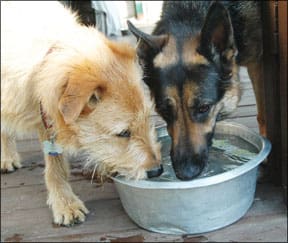
Boiling vegetables in water greatly reduces their oxalate content, while steaming reduces levels slightly. Of course, boiling reduces nutritional content, so it’s a trade-off. When you feed Group 3 (moderate-oxalate) vegetables, consider giving smaller amounts raw and larger amounts cooked. Adding digestive enzymes to food at serving time helps replace enzymes destroyed by heat.
Most 10-pound dogs need less than 1 cup of food by volume, while dogs weighing 50 pounds may need closer to 3 cups per day. Bean’s Lhasas maintain their 12- to 14-pound body weight on slightly more than 1 cup per day. The amount to feed will vary according to your dog’s activity level and the amount of low-calorie vegetables in the diet. Because key supplements should be given twice a day with food, consider feeding breakfast and dinner rather than one meal per day.
Calcium
In the past, calcium was thought to be a risk factor for the formation of calcium oxalate stones. Later studies found, however, that calcium binds oxalate and thus actually reduces the risk of calcium oxalate stones when given with meals.
When she spoke with urologists who deal with human kidney stones, Bean learned that supplementing homemade food with calcium citrate neutralizes oxalates in urine, so she began giving it to her dogs with meals while avoiding all other mineral supplements. “Citrate is an important natural inhibitor of calcium oxalate stones,” she says. “When calcium citrate is combined with food at mealtime, it helps absorb and bind excess oxalic acid in the gut. This bound oxalate cannot be absorbed and is excreted through the feces. This means that it does not get into the bloodstream or kidneys to cause stones.”
Pure calcium citrate powder is inexpensive and easy to use. Bean adds 300 to 350 mg of NOW brand Vegetarian Powdered Calcium Citrate to each 8 ounces (½ pound) of fresh food to balance the diet’s calcium:phosphorus ratio. Calcium citrate should only be added to homemade diets, or to the fresh portion of a combined diet, as commercial diets should already contain the right amount of calcium (though, unfortunately, they rarely use calcium citrate).
Supplements
For more than 40 years, the medical literature has reported on the success of a simple nutritional therapy for the prevention of calcium oxalate stones in humans using magnesium and vitamin B6. In studies published in The American Journal of Clinical Nutrition, The Journal of the American College of Nutrition, and other medical journals since 1967, patients with longstanding, recurrent calcium oxalate kidney stones received 200, 300, or 500 mg magnesium oxide with or without 10 mg pyridoxine (vitamin B6) daily for five years or more, during which their stone formation fell by more than 90 percent. When measured, their urine increased its ability to keep calcium oxalate in solution.
Because vitamin B6 deficiencies can contribute to an increase in oxalate production, many veterinarians prescribe this vitamin for dogs prone to CaOx stones. Severe vitamin B6 deficiencies may result from genetic disorders. Vitamin B6 is available as an oral supplement or by injection. Follow label directions or, if using a human product, give ¼ of the total dose for each 25 pounds of body weight.
A B-complex supplement provides all of the needed B-family vitamins. Give 50 mg twice per day to dogs weighing 50 pounds or more, and one-fourth or half that amount to smaller dogs. The FuzzerFood regimen includes Omega-3 fish or salmon oil, a B-complex vitamin, and vitamin E, with optional CoQ10, magnesium, glucosamine, digestive enzymes, and probiotics.
Magnesium can have a laxative effect, so begin at the low end of the range, which is 3 to 5 mg per pound of body weight per day, divided into morning and evening doses and given with meals. Magnesium supplementation is contraindicated for dogs in renal failure, so if that is your dog’s condition, use this under your veterinarian’s supervision only as long as there are stones, then discontinue.
Bean does not use either vitamin C or vitamin D (including cod liver oil, which contains vitamin D) because vitamin C is reported to convert to oxalate, thus possibly increasing the risk of stone formation, and vitamin D promotes calcium absorption, which leads to increased urinary calcium.Most multi-vitamins contain vitamins C and D, so it’s important to read labels.
Supplements manufactured for human consumption come in a wider variety than do veterinary supplements, making it easier to find human products that avoid these ingredients. Adjust the recommended human dose for your dog by weight.
Some researchers have found that glucosamine supplements, which are commonly used for arthritis, may help prevent calcium oxalate crystals from adhering to the bladder wall. While this treatment is still speculative, glucosamine is safe to give and may be helpful in preventing CaOx bladder stone formation.
When Bean asked Traditional Chinese Medicine veterinarian Cory Stiles, DVM, for advice from that perspective, Dr. Stiles recommended Lysimachia-3, a traditional Chinese blend of three herbs, Jin Qian Cao or Desmodium, Hai Jin Sha or Lygodium Spores, and Ji Nei Jin or Gallus, which is designed to treat human digestive disorders, gall stones, and kidney stones.
“Lysimachia-3 comes in tablets,” says Bean, “which we crushed and mixed with food, or the tablet can be placed in a small amount of low-fat cream cheese, or the dog can simply be ‘pilled’ by putting it down the throat. My dogs had no objection to having these tablets crushed and mixed with their food, and Lhasas are notoriously picky.” Dr. Stiles’ recommended dose is 1 tablet per 25 pounds body weight given twice daily until stones are dissolved. Then give Lysimachia-3 daily for another month, then start using it every other day, then every three days, and if all looks good, dose it three times per week every other week, and finally, daily for one week out of every four to six weeks.
Preventive medical treatment
Potassium citrate is a nutritional supplement that increases citrate levels in the urine, attracting calcium away from oxalates. When calcium binds to citrate, the resulting calcium citrate tends to remain dissolved instead of precipitating out as a mineral deposit. Potassium citrate also has an alkalizing effect on the urine, which can help to prevent the formation of calcium oxalate stones, though it won’t dissolve existing stones. High blood potassium levels are dangerous, so a veterinarian’s supervision and follow-up blood tests are recommended when using potassium citrate. This supplement should usually not be given when dietary changes alone maintain the urine’s pH at 6.5 or above.
Calcium citrate achieves the same goals of alkalizing urine and binding oxalates without the risk of elevated potassium that can be posed by potassium citrate. That’s why Bean considers calcium citrate a better option for her dogs’ homemade diets.
Dogs who continue to form stones despite other steps to minimize risk may be prescribed hydrochlorothiazide, a thiazide diuretic, to increase the amount of urine produced while reducing urinary calcium oxalate saturation.
The stress connection
In addition to good food and ample water, dogs need a stable home life, active exercise, and interesting activities. Some researchers speculate that stress plays a role in the development of kidney and bladder stones. When changing your dog’s diet, do what you can to keep the introduction of new foods fun and stress-free. Fortunately, most dogs love fresh food. Just as importantly, do what you can to relax and let go of the stress that concern about your dog’s health brings to your own life. The more you and your best friend enjoy each other’s company with play, exercise, and shared quiet moments, the better you’ll both feel.
Next month: The final installment of our bladder/kidney stone series examines cystine, calcium phosphate, silica, and ammonium urate or uric acid uroliths.
CJ Puotinen is the author of The Encyclopedia of Natural Pet Care and other holistic health books. She lives in Montana, and is a frequent contributor to WDJ.
San Francisco Bay Area resident Mary Straus has spent more than a decade investigating and writing about canine health and nutrition topics for her website, DogAware.com.


